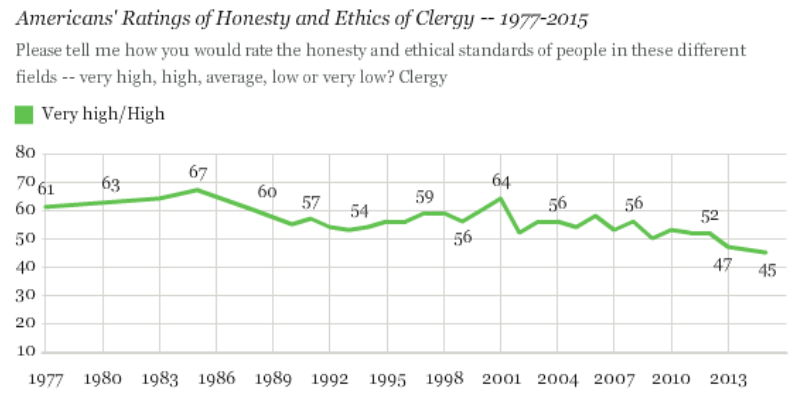In today’s edition: Congress as honest as telemarketers; the GOP’s diploma dilemma; all-mail elections don’t increase turnout like you think; and North Carolina joins the 10 Million Club.
A Decade Of Distrust
When the cultural history of the last ten years is written, when weightier matters like war and recession are perhaps behind us, we may recall this as the decade when Americans lost trust — not just in our politicians, but in virtually every institution that plays a major role in society.
This is the decade of scandal, the decade in which abuse allegations against the Catholic Church became major news. This is the decade in which Barry Bonds was indicted, when Lance Armstrong was stripped of his titles. The recession itself was exacerbated by Wall Street traders playing ratings agencies for fools with complex financial instruments, and no one went to jail.
It is a decade of declining trust in media, a phenomenon concurrent with the rise of purely partisan outlets on the right and the left. The divide between Americans’ perceptions of how they are treated versus how they think powerful interests like the police, big business and political insiders are treated has never been wider.
And that’s before we get to the scandals that rocked Washington beginning in 2006, and the poisonous mistrust between party faithful on both sides. It is easier, political professionals have discovered, to play on mistrust than to inspire trust, hence the proliferation of negativity and hyperbole in politics.
An annual Gallup poll released this week underscores our pessimistic view of society: Only 45 percent of Americans say they believe clergymen have high or very high standards of ethics and honesty, down from a peak of 64 percent in 2001. Today, just about a quarter of voters say they believe bankers, journalists and lawyers have high or very high standards of ethics. Fewer than one in five say the same about labor union leaders, business executives or stock brokers.
Just 8 percent of Americans believe members of Congress have strong ethical standards, on par with telemarketers and car salespeople, a statistic that sounds like the punchline to a joke.
The problems facing the next president are already massive: Instability in the Middle East and Africa, a global migration crisis, an economy still teetering on the brink, and the threat of terrorism at home. That he or she will inherit 330 million constituents who distrust each other, their government and their institutions only makes the most difficult job in the world all the more daunting.
The College Divide
As the economy slowly recovers from the worst recession in decades, a stark divide has emerged between those with college educations and those without. The unemployment rate for non-college graduates spiked sharply in recent years, while the college unemployment rate rose at a much slower pace.
Put it another way: White non-college graduates are the subgroup that feels most strongly that the country is moving away from them — and they’re angry about it.
As David Wasserman writes at FiveThirtyEight, that divide is showing up in the race for the Republican presidential nomination. Voters without a degree are much more likely to favor Donald Trump or Sen. Ted Cruz (R-Texas) than those with college degrees; Sen. Marco Rubio (R-Fla.), on the other hand, does better among those with college degrees.
Take a look at Tuesday’s Quinnipiac poll for a stark example: Trump scores six points higher among those without college degrees than among those with a degree, 30 percent versus 24 percent. Cruz does five points better, 26 percent to 21 percent, among the less educated (so does Ben Carson). Rubio, on the other hand, does ten points better — 19 percent to 9 percent — among those who have a college education.
Iowa’s Republican electorate is likely to be less well-educated than New Hampshire’s; 2012 exit polls showed 52 percent of Iowa Republicans had a college degree, less than the 55 percent of New Hampshire Republicans who said the same. In South Carolina, just 47 percent have a college degree. Among March 1 super Tuesday states, states like Mississippi, Arkansas, Oklahoma and Tennessee sit near the bottom of national educational attainment rankings.
Add that factor to Cruz’s focus on those SEC states and it only bolsters the Texan’s case for front-runner status. If, that is, he can consolidate the non-college vote from his most immediate rival, Trump.
In a general election, the diploma gap is even more pronounced: Hillary Clinton beats all of her potential Republican rivals by double digits among those with a college degree, while every Republican wins among non-college voters.
General Election Matchups (Quinnipiac)
Non
All Col Col
Clinton 47% 57% 42%
Trump 40 33 43
Clinton 44 52 40
Rubio 43 41 44
Clinton 44 54 40
Cruz 44 39 46
Is this another demographic trend that’s moving away from the Republican Party? Well, yes and no. The percentage of college graduates as a share of the electorate has risen in recent years, though Republicans made inroads among college graduates between 2008 and 2012.
Share of Electorate
Non
Col Col
2012 47% 53%
2008 45 55
2004 42 58
Presidential Performance By Education
-2012-- -2008-- -2004--
Col Non Col Non Col Non
Dem 50% 51% 53% 53% 49% 47%
GOP 48 47 45 46 49 53
There’s virtually no diploma gap on the Democratic side: Clinton and Sen. Bernie Sanders (I-Vt.) perform almost identically among those with and without a college degree. For Democrats, there’s a values gap: Clinton leads Sanders by a 61 percent to 30 percent margin among all Democrats and Democratic leaners. She leads by just five points, 51 percent to 46 percent, among those who say their most important consideration is which candidate shares their values.
Turnout For What?
The higher the turnout, conventional wisdom goes, the better for Democrats. And the easier it is to vote, the higher turnout will be. But political science research doesn’t necessarily back up the notion that one of Democrats’ favorite methods for increasing turnout — conducting elections entirely by mail — necessarily works.
Three states conduct elections entirely by mail: Oregon, Washington and Colorado. Early studies showed turnout in Oregon and Washington, and in some California counties, increased marginally with the use of all-mail ballots.
But a new study conducted by Cal State University political scientist Elizabeth Bergman suggests turnout actually drops by 13 percent using all-mail ballots. Counterintuitive? Of course. Bergman says the longer window voters have to cast their ballot actually reduces the stimulus to vote.
The key to boosting turnout, as it turns out (har har), is a reminder. Voters who are reminded to cast their ballots are far more likely to actually vote than those who just get their ballots in the mail. The increase is particularly pronounced among Asian American and Latino voters.
No wonder, then, that both parties spend so much effort combing lists of registered absentee voters in states that don’t conduct elections entirely through the mail. The smartest campaigns are able to target their messaging to those voters who have yet to return their ballot; in essence, the voter pool decreases in the three weeks or so between the day absentee ballots arrive and Election Day.
The Tar Heel Ten (Million)
North Carolina is the ninth state to surpass the 10 million resident mark, the Census Bureau said Tuesday. The Tar Heel state’s population has grown by just over 5 percent since 2010.
Other states have grown faster: North Dakota’s population has soared by 12.2 percent over the last five years, fueled by the fracking boom that now looks like it’s slowing down. Texas and Colorado grew by more than 8 percent each. Only one state — West Virginia — saw its population shrink since 2010. About 10,000 fewer residents call West Virginia home today than in 2010.
States (and D.C.) with the highest growth rates:
2010 2015 Change
North Dakota 674,530 756,927 +12.2
Washington DC 605,126 672,228 +11.1
Texas 25,244,363 27,469,114 +8.8
Colorado 5,048,254 5,456,574 +8.1
Utah 2,775,426 2,995,919 +7.9
Florida 18,849,890 20,271,272 +7.5
Nevada 2,703,440 2,890,845 +6.9
Arizona 6,408,208 6,828,065 +6.5
Washington 6,743,060 7,170,351 +6.3
S. Carolina 4,635,894 4,896,146 +5.6
States with the lowest growth rates:
2010 2015 Change
West Virginia 1,854,225 1,844,128 -0.5%
Vermont 625,984 626,042 +0.0
Maine 1,327,695 1,329,328 +0.1
Illinois 12,841,249 12,859,995 +0.1
Rhode Island 1,053,219 1,056,298 +0.3


